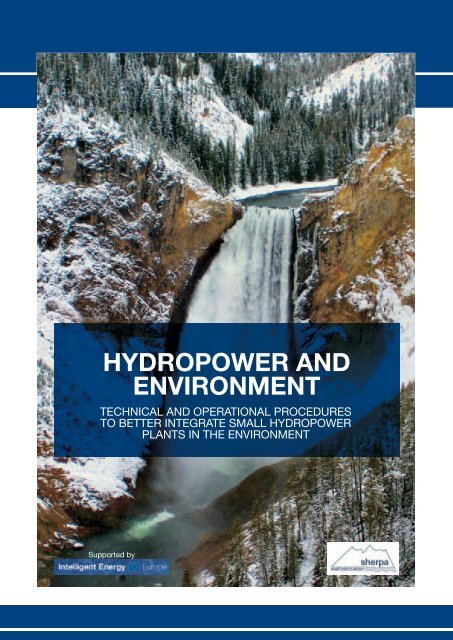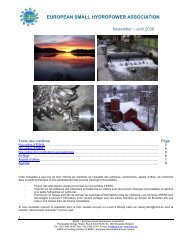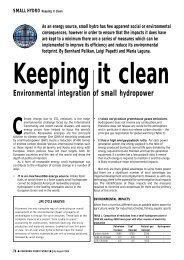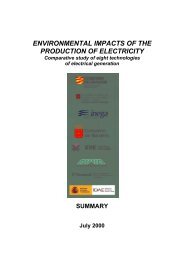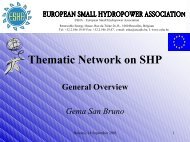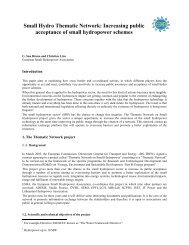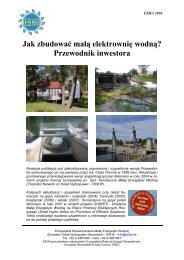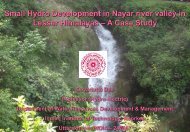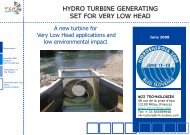HYDROPOWER AND ENVIRONMENT - ESHA
HYDROPOWER AND ENVIRONMENT - ESHA
HYDROPOWER AND ENVIRONMENT - ESHA
You also want an ePaper? Increase the reach of your titles
YUMPU automatically turns print PDFs into web optimized ePapers that Google loves.
<strong>HYDROPOWER</strong> <strong>AND</strong><br />
<strong>ENVIRONMENT</strong><br />
TECHNICAL <strong>AND</strong> OPERATIONAL PROCEDURES<br />
TO BETTER INTEGRATE SMALL <strong>HYDROPOWER</strong><br />
PLANTS IN THE <strong>ENVIRONMENT</strong><br />
Supported by
This brochure has been developed under SHERPA<br />
project – Small Hydro Energy Effi cient Promotion<br />
Campaign Action.<br />
SHERPA is a European Funded Project in the framework<br />
of the Intelligent Energy for Europe Programme<br />
(IEE).<br />
SHERPA aims to make a signifi cant contribution in<br />
reducing the barriers that are currently hindering the<br />
development of SHP, addressing the challenges and<br />
contributing to the uptake of SHP in the new enlarged<br />
European Union.<br />
The result of SHERPA will not only increase the<br />
awareness of politicians and decision makers on<br />
SHP as a key renewable energy source, but will also<br />
create favourable framework conditions for the further<br />
uptake of SHP within the European Union.<br />
The project specifi cally addresses the issue of environmental<br />
performance of SHP plants, as well as<br />
a comprehensive territorial planning approach at the<br />
level of water bodies.<br />
<strong>ESHA</strong>, the European Small Hydropower Association,<br />
is the European co-ordinator of this project, which<br />
includes eight additional partners: SSHA (Slovenia),<br />
LHA (Lithuania), APER (Italy), SERO (Sweden), IED<br />
(France), IWHW (Austria), EC BREC/CLN (Poland),<br />
ADEME (France).<br />
This brochure has been coordinated by Sara Gollessi<br />
and Giulia Valerio from APER (Italy).<br />
We wish to thank <strong>ESHA</strong> staff for the revision and other<br />
SHERPA partners for their contributions.
INDEX<br />
INTRODUCTION<br />
1. LOW IMPACT HYDRO PLANNING<br />
1.1. MULTIPURPOSE SCHEMES<br />
1.1.1. SHP along irrigation channels<br />
1.1.2. SHP along drinking water supply systems<br />
1.1.3. SHP along waste water systems<br />
1.2. RESTORATION OF ANCIENT WATER MILLS<br />
CASE STUDY n. 1: Hydro plants on Muzza channel, Lodi, Italy.<br />
CASE STUDY n. 2: An hydro plant on a drinking water supply system, Ascoli Piceno, Italy.<br />
1.3. UPGRADING <strong>AND</strong> REPOWERING OF EXISTING SHP<br />
2. MITIGATION MEASURES<br />
2.1. RESERVED FLOW<br />
2.2. AESTHETICAL IMPROVEMENT<br />
2.2.1. Powerhouse<br />
2.2.2. Penstocks<br />
2.3. NOISE REDUCTION<br />
CASE STUDY n. 3: Cordiñanes hydro plant, Picos de Europa, Spain.<br />
2.4. FISH PASSES<br />
CASE STUDY n. 4: Restoration of migration path on the Sava river, Tacen, Slovenia<br />
2.5. FISH-FRIENDLY TURBINES<br />
CASE STUDY n. 5: Feasibility study regarding the establishment of ecological turbines<br />
on Cèze river<br />
3. ADDITIONAL BENEFITS<br />
3.1. TRASH RACK MATERIAL MANAGEMENT<br />
3.2. INTEGRATION OF OTHER <strong>ENVIRONMENT</strong>AL PURPOSES<br />
3.3. HYDRAULIC-FOREST ARRANGEMENT<br />
4. CONCLUSIONS<br />
3<br />
page<br />
4<br />
6<br />
7<br />
8<br />
9<br />
10<br />
11<br />
13<br />
14<br />
15<br />
16<br />
18<br />
19<br />
20<br />
22
INTRODUCTION<br />
INTRODUCTION<br />
Hydropower is a key source for renewable electricity<br />
generation and has an important potential to be marketed<br />
as green power. While offering ecological advantages<br />
from a global perspective, such as climate<br />
change mitigation, emergency management and reduction<br />
of fl ooding risk, the construction and operation<br />
of hydropower plants may cause some environmental<br />
impacts on the local and regional level. These<br />
include harm to fi sh populations, a loss of aquatic<br />
habitat, a signifi cant change in natural fl ow regimes<br />
and deterioration of the landscape. The following table<br />
lists the main positive and negative impacts of<br />
hydropower. As a result, a contrast between two different<br />
but well-grounded environmental goals seems<br />
apparently insoluble: green-house effect reduction,<br />
on the one hand, and water habitat protection, on<br />
the other. This is a very weak point that has important<br />
consequences from a regulative point of view,<br />
as refl ected in the contradictions between the objectives<br />
and targets set by two key European Directives:<br />
WFD (Water Framework Directive) and RES-e (Renewable<br />
Energy Sources electricity Directive). Nevertheless,<br />
there are different solutions that can reduce<br />
these contrasts and promote, as a consequence, the<br />
achievement of a higher environmental quality.<br />
First of all, the choice of Small Hydropower,<br />
i.e. plants with a capacity of less than 10 MW: they<br />
are often run-of-river hydro plants and, thanks to the<br />
absence of a storage basin, have a minor impact on<br />
the hydrological regime of the river, one of the most<br />
important sources of environmental impact.<br />
THE <strong>ENVIRONMENT</strong>AL PROBLEM: A BALANCE<br />
Secondly, the application of a careful and modern<br />
design based on the application of mitigation<br />
and compensation measures that can ameliorate<br />
integration of Small Hydro Plants (SHP) in the environment.<br />
The aim of this report is to describe a new concept<br />
of hydropower design, more environmentally-friendly<br />
than the traditional one. Nowadays, when climate<br />
change and water resource management have been<br />
defi ned as the major international problems faced by<br />
the International Community, this sort of approach<br />
seems to be the only rational way to continue using a<br />
reliable source of renewable energy while at the same<br />
time maintaining a healthy environment and a sustai-<br />
nable ecosystem.<br />
1 GWh produced by a SHP plant avoids on average<br />
the emissions of about 480 tons of CO 2<br />
4
REPORT ON TECHNICAL <strong>AND</strong> OPERATIONAL PROCEDURE TO BETTER INTEGRATE SMALL HYDRO PLANTS IN THE <strong>ENVIRONMENT</strong><br />
ACTIONS DURING OPERATION<br />
Renewable energy production<br />
Presence of a trash rack cleaning machine<br />
Presence of anthropogenic structures<br />
(powerhouse, electric lines, penstocks, ripraps)<br />
Main impacts of a hydro plant on the environment<br />
5<br />
IMPACTS<br />
Avoid green-house<br />
gas emissions<br />
Removal of<br />
anthropogenic waste<br />
from the water for free<br />
Visual intrusion<br />
Possible movement<br />
barriers for animals<br />
PERSONS OR OBJECTS<br />
AFFECTED<br />
General public<br />
Raising of river banks near<br />
to the diversion works<br />
Presence of a storage basin<br />
Flood protection<br />
General public<br />
Water diversion<br />
Water diversion<br />
Impoundment generated by weirs<br />
in backwater areas<br />
Operation of hydroelectric unit,<br />
speed increasers, trash rack cleaner,<br />
trash conveyor<br />
J<br />
J<br />
J<br />
L<br />
L<br />
L<br />
L<br />
L<br />
Habitat modifi cation<br />
due to the interruption<br />
of spatial and temporal<br />
continuity of rivers<br />
Creation of a barrier<br />
for fi sh passage<br />
Death of a certain percentage<br />
of fi sh passing<br />
through the turbine<br />
Alteration of natural<br />
habitat conditions<br />
(reduction of fl ow<br />
velocity and consequent<br />
sedimentation)<br />
Noise emission<br />
General public<br />
Aquatic ecosystem and<br />
environment in general<br />
Aquatic ecosystem and<br />
environment in general<br />
General public, animals<br />
and environment in general<br />
Aquatic ecosystem<br />
General public and<br />
environment in general
LOW IMPACT HYDRO PLANNING<br />
1LOW IMPACT<br />
HYDRO PLANNING<br />
Before an in depth analysis of the technical procedures<br />
that can mitigate the negative effects of SHP<br />
on the environment, it is crucial to underline the existence<br />
of planning solutions intrinsically presenting a<br />
very low environmental impact. Here we are talking<br />
about the hydroelectric production realized on existing<br />
structures, that itself exploits water diversion,<br />
and also about those that develop marginal potential<br />
present on an anthropical area. In this way, the<br />
impacts connected to the use of a vital and limited<br />
resource and to the location in a natural place are<br />
strongly reduced, while at the same time the environmental<br />
benefi t is maximized due to renewable energy<br />
production, i.e. the reduction of greenhouse emissions.<br />
This sort of planning can be considered as an<br />
effort to rationalize water resource exploitation and to<br />
optimize human actions on the environment, which is a<br />
strategy, shared at an international level, to achieve the<br />
goal of a sustainable way of life that would not threaten<br />
future generations. In order to promote this way of<br />
planning, it is essential to develop an integrated and<br />
multidisciplinary approach in water-resource management;<br />
also these hydro-schemes have a future<br />
only if they are supported by economic incentives<br />
and simplifi ed administrative procedures.<br />
1.1<br />
MULTIPURPOSE SCHEMES<br />
INTEGRATION<br />
Water is an essential need in a wide range of human<br />
activities, such as hydroelectric power generation,<br />
irrigation, water supply and domestic life. Year<br />
after year, this requirement is becoming more and<br />
more intense, in contrast with the limited nature of<br />
the resource and the problems connected with the<br />
compromise of the quality of available freshwater.<br />
Accordingly, this situation intensifi es the resource<br />
exploitation and creates a strong competition between<br />
different water uses. A sustainable development<br />
therefore demands a sustainable management<br />
of the world’s limited resources of water, in order to<br />
6<br />
meet the needs of society, to permit mitigation of water-related<br />
hazards, and to maintain or enhance the<br />
condition of the global environment. In an integrated<br />
water resource management perspective, the multipurpose<br />
hydro plants fi nd a more suited position. A<br />
multipurpose scheme is one that combines different<br />
water uses in a single diversion. In these schemes,<br />
energy production is not the only and often not the<br />
main goal of water exploitation and, for this reason,<br />
“Water is necessary in all aspects of life.<br />
[...] Its multi-sectorial nature must be recognized<br />
in the context of socio-economic<br />
development and, as a consequence,<br />
the essential role that it carries out in<br />
a whole series of indispensable operations:<br />
from the supplying of drinking water<br />
to hygiene-sanitary conditions, from<br />
agricultural to industrial production,<br />
from urban expansion to the production<br />
of hydroelectric energy, from transport<br />
to recreation and tourism and numerous<br />
other activities”.<br />
-From: Agenda 21, Rio de Janeiro, 1992-<br />
it can be seen as an example of rational exploitation<br />
of the resource and an effort towards environmental<br />
sustainability. This results in the best compromise<br />
between different public interests while reducing
REPORT ON TECHNICAL <strong>AND</strong> OPERATIONAL PROCEDURE TO BETTER INTEGRATE SMALL HYDRO PLANTS IN THE <strong>ENVIRONMENT</strong><br />
environmental impacts. In particular, when a plant is<br />
built in order to use an existing discharge, it has the<br />
only benefi t of reducing green house gas emissions<br />
with no extra negative impacts on the environment.<br />
Hereafter, some examples of multipurpose hydro<br />
plants are shown.<br />
1.1.1<br />
SHP along irrigation channels<br />
( CASE STUDY N.1)<br />
Some small hydro plants, especially low-heads plants,<br />
have been realized along existing irrigation channels to<br />
use part of the water that has just been diverted to irrigate<br />
fi elds.<br />
1.1.2<br />
SHP along drinking water supply<br />
system ( CASE STUDY N.2)<br />
Many drinking water systems, especially in mountainous<br />
areas, are characterized by high water heads, that<br />
can be exploited for energy production, instead of being<br />
dissipated in relief valves. In fact, when there is<br />
a signifi cant difference in height between the intake<br />
and the fi nal point of distribution, it is necessary to<br />
install some relief valves to reduce water pressure and<br />
avoid problems in the downstream equipment and<br />
pipes. The same effect can be obtained by installing<br />
a turbine. In this way the surplus water pressure can<br />
be exploited for energy production and the aqueduct<br />
manager has a supplementary economical benefi t<br />
thanks to the energy sale.<br />
1.1.3<br />
➡<br />
➡<br />
SHP along waste water system<br />
Some waste water treatment systems are characterized<br />
by signifi cant water heads above or below the<br />
plants. These can be exploited through a hydro plant,<br />
that needs, only in the fi rst case, a pre-treatment.<br />
7<br />
1.2<br />
RESTORATION OF ANCIENT<br />
WATER MILLS<br />
The fi rst hydraulic machine capable of exploiting water<br />
power was the wheel, a simple and ingenious machine<br />
that could provide mechanical energy taking<br />
advantage of the natural slopes of the waterways or<br />
falls artifi cially created with simple derivations. Romans<br />
were the fi rst to use them, but it is above all<br />
in the Middle Ages that wheels became much more<br />
widely used, enough to become year after year a primary<br />
energy source.<br />
A WATER-MILL IN DENMARK<br />
REUTILIZATION<br />
Nowadays, in the European countries it is still possible<br />
to see many abandoned water-mills near to old<br />
farmsteads that could be upgraded and reutilized.<br />
In this way, an existent energetic potential would be<br />
appreciated, and hydroelectricity could become an<br />
opportunity to safeguard our cultural and historical<br />
heritage.
LOW IMPACT HYDRO PLANNING<br />
CASE STUDY<br />
CASE STUDY N°1:<br />
Hydro plants on Muzza channel, Lodi, Italy<br />
Muzza is the oldest diversion channel realized on<br />
the natural watercourse Adda, which is an important<br />
tributary of the Po river located in northern Italy.<br />
Beginning from Muzza, a network of artifi cial channels<br />
have been developed: they run for about 6000<br />
Turbines<br />
Net head [m]<br />
Average discharge [m3 /s]<br />
Installed capacity [kW]<br />
Average generation [kWh/year]<br />
1<br />
2<br />
3 4<br />
LAMBRO river<br />
ADDA river<br />
Contact:<br />
Fausto Cremascoli<br />
Consorzio di Bonifi ca<br />
Muzza Bassa Lodigiana<br />
Via Nino Dall’Oro 4<br />
26900 Lodi – Italy<br />
territorio@muzza.it<br />
PAULLO<br />
Kaplan (2)<br />
3,79<br />
59,80<br />
2.600<br />
14.000.000<br />
1 PAULLO<br />
Source:<br />
CONSORZIO MUZZA BASSA<br />
LODIGIANA<br />
8<br />
km and irrigate 735,1 km2 of fi elds. Along Muzza, 4<br />
run-of-river hydro plants are operational: in this way,<br />
agriculture has been well integrated with hydroelectric<br />
production, through an optimisation of water resource<br />
exploitation.<br />
BOLENZANA<br />
Kaplan (2)<br />
3,52<br />
52,50<br />
1.800<br />
13.500.000<br />
2 BOLENZANA<br />
Source:<br />
CONSORZIO MUZZA BASSA<br />
LODIGIANA<br />
PO river<br />
Small hydro plants on the irrigation channel Muzza, Italy.<br />
J<br />
Environmental benefi ts:<br />
BELGIARDINO<br />
Kaplan (2)<br />
9,69<br />
14,00<br />
2.200<br />
9.500.000<br />
QUARTIANO<br />
Kaplan (1)<br />
3,5<br />
48,02<br />
1.400<br />
13.000.000<br />
3 QUARTIANO D’ADDA<br />
Source:<br />
CONSORZIO MUZZA BASSA<br />
LODIGIANA<br />
4 BELGIARDINO<br />
Source:<br />
CONSORZIO MUZZA BASSA<br />
LODIGIANA<br />
Multiple water use: rational exploitation of the resource<br />
Location in a still anthropogenic place and use of the local<br />
architectural style: small impact on the landscape<br />
Electrical production as a secondary scope of water use:<br />
hydro plants with low environmental impact
REPORT ON TECHNICAL <strong>AND</strong> OPERATIONAL PROCEDURE TO BETTER INTEGRATE SMALL HYDRO PLANTS IN THE <strong>ENVIRONMENT</strong><br />
CASE STUDY<br />
CASE STUDY N°2:<br />
An hydro plant on a drinking water supply<br />
system, Ascoli Piceno, Italy<br />
Rovetino is a SHP that exploits a water head present<br />
along a mountain supply system located in Italy, that<br />
otherwise should be dissipated by pressure regulation<br />
valves to avoid problems in the downstream<br />
pipes and equipment. To assure a compatible coexistence<br />
of energy and water supply use, the adoption<br />
of proper technology is needed in this sort of hydro<br />
planning:<br />
- installation of turbines without lubricated organs in<br />
contact with water and choice of proper materials<br />
(stainless steel for runner and guide-vanes, cast iron<br />
Source: HYDROWATT<br />
{<br />
Water head exploited<br />
by Rovetino hydroplant<br />
Hydraulic grade line in the aqueduct of Monti Sibillini,<br />
Ascoli Piceno, Italy. J<br />
Contact:<br />
Ruggero Recchioni<br />
Hydrowatt Spa<br />
Via Verdi 7, Piane di Morro<br />
63040 Folignano (AP) - Italy<br />
ruggerorecchioni@hydrowatt.it<br />
9<br />
for turbine box). In this way, every kind of drinking<br />
water pollution is avoided;<br />
- installation of reaction turbines, which give back<br />
water with a proper pressure, to assure the effi ciency<br />
of the water supply system;<br />
- creation of an automatic by-pass to assure a continuous<br />
water fl ow even in presence of an interruption<br />
of the hydro plant operation;<br />
- management of the hydro plant with a remote control<br />
system: by monitoring and modifying the operation<br />
conditions, a good service of the aqueduct is<br />
guaranteed.<br />
Turbines<br />
Net head [m]<br />
Average discharge [m3 /s]<br />
Installed capacity [kW]<br />
Average generation [kWh/year]<br />
Environmental benefi ts:<br />
ROVETINO<br />
Francis (3)<br />
180 + 40<br />
0,27 + 0,25<br />
760<br />
4.000.000<br />
Multiple water use: rational exploitation of the<br />
resource<br />
Location in a still anthropogenic place:<br />
minor impact on the landscape<br />
Electrical production as a secondary scope<br />
of water use: hydro plants with low environmental<br />
impact<br />
Optimisation of the aqueduct costs, thanks to<br />
the use of energy produced for the pumping<br />
systems<br />
On-site generation: reduction of energy losses<br />
due to long distance electricity transport
LOW IMPACT HYDRO PLANNING<br />
1.3<br />
UPGRADING <strong>AND</strong> REPOWERING<br />
OF EXISTING SHP<br />
EFFICIENCY<br />
It is quite intuitive to understand that the upgrading<br />
and extension of existing facilities generate impacts<br />
that are quite different from an entirely new scheme.<br />
In these cases, in fact, some of the anthropical structures<br />
are maintained, such as the powerhouse and<br />
penstocks, without any consequent visual impact of<br />
the action. Even better, the pre-existent structures<br />
can be modernized by adopting new techniques that<br />
can mitigate this sort of impact.<br />
In this context some particularly well accepted<br />
projects are the ones directed towards the increase<br />
of machine effi ciency and reduction of water head<br />
losses, i.e. towards an upgrading of the whole yield of<br />
the transformation. As the following formula shows,<br />
the effect is an increase of the plant capacity and<br />
production, under the same discharge conditions.<br />
Effi ciency %<br />
... More energy with the same water ...<br />
NEW TURBINES<br />
Effect of repowering on turbine effi ciency<br />
OLD TURBINES<br />
Capacity [MW]<br />
Source: ENEL<br />
10<br />
P =ηγQH<br />
where:<br />
- Q is the volumetric discharge;<br />
- H is the gross head, calculated as the difference between<br />
the geodetic head and the water head losses;<br />
- γ is the water specifi c weight;<br />
- η is the plant effi ciency, calculated by the product<br />
of the effi ciencies of turbine, generator, speed increaser<br />
and transformer.<br />
In other words, these projects turn the hydro capacity<br />
increase to the advantage of the producer, that<br />
can sell more energy, and to the environment too,<br />
because of the percentage growth of renewable energy<br />
production.<br />
In Europe, where the sector started to develop 150<br />
years ago, there is a consistent potential in repowering<br />
old hydro plants.<br />
The European Project “Blue Age<br />
for a green Europe” (2002) is<br />
focused on the study of the potential<br />
of SHP in Europe. The estimation<br />
of the residual potential<br />
only under technical constraints<br />
is 2080 MW (8100 GWh/year) by<br />
upgrading existing plants.<br />
http://www.esha.be/fileadmin/<br />
esha_fi les/documents/publications/publications/BlueAGE.pdf
REPORT ON TECHNICAL <strong>AND</strong> OPERATIONAL PROCEDURE TO BETTER INTEGRATE SMALL HYDRO PLANTS IN THE <strong>ENVIRONMENT</strong><br />
2MITIGATION<br />
MEASURES<br />
As previously mentioned, the construction and operation<br />
of SHP may cause quite severe environmental<br />
impacts on the local and regional level, affecting<br />
water resources, some biological communities and<br />
landscape. Nevertheless, a careful design and rational<br />
operation can mitigate these effects and strongly<br />
improve the integration of the plant within the natural<br />
context in which it is built. Hereafter, some of the<br />
most effective mitigation measures are shown.<br />
2.1<br />
RESERVED FLOW<br />
FLEXIBILITY<br />
Water diversion, which deprives a reach of a part of<br />
its natural fl ow, is the key-problem concerning the<br />
environmental impact of small hydro plants. So, in<br />
order to make hydropower production more compatible<br />
with the natural life of rivers, a minimum fl ow<br />
must be released so as to assure the preservation of<br />
the hydrological continuity of the river and the consequent<br />
conservation of natural habitat and ecological<br />
life.<br />
Most of reserved fl ow defi nitions underline the will<br />
to achieve biocenosis protection and a good aquatic<br />
ecosystem quality. Nevertheless, it is quite diffi cult to<br />
express these biological aspects in a mathematical<br />
formula: nowadays there isn’t yet a universally valid<br />
solution to calculate reserved fl ow.<br />
As the following table shows, the most diffused calculation<br />
methods are based on empirical formulae<br />
that express reserved fl ow as a function of different<br />
variables (morphological, statistical and hydrological).<br />
They are very easy to apply, but also simplifi ed and<br />
often unrelated to the biological factors. On the contrary,<br />
methods based on multi-objective and experimental<br />
planning, taking into consideration ecological<br />
parameters too, are very expensive and complex in<br />
data collection and mathematical computing, but also<br />
much more effi cient. In fact a common belief, shared<br />
by ecologist associations too, is that it is almost impossible<br />
to extrapolate the optimum reserved fl ow to<br />
11<br />
a vast area. For this reason up to now the only way of<br />
assuring the goal of effi cient environmental protection,<br />
without any useless loss of renewable energy, is<br />
through experimentation, based on specifi c morphological,<br />
hydrological and ecological conditions.<br />
In the future, a desirable outlook is the diffusion of<br />
experimental methods, where one can measure the<br />
real effects of a discharge release on fl uvial environments.<br />
Future evaluations of environmental fl ow are<br />
encouraged to take into account the principles of<br />
this sort of approach:<br />
Source: APER<br />
fi eld activities and modelling;<br />
site-specifi c approach;<br />
integrated vision of the ecosystem;<br />
variability of reserved fl ow;<br />
multi-criteria evaluation;<br />
collaboration between competences.<br />
COOPERATION BETWEEN ECOLOGISTS<br />
<strong>AND</strong> ENGINEERS IN A FIELD ACTIVITY
MITIGATION MEASURES<br />
COUNTRY<br />
AUSTRIA<br />
NOT REGULATED<br />
FRANCE X<br />
WATER USE<br />
AUTHORIZATION<br />
CONSTRAINT<br />
X X<br />
RESPONSIBLE<br />
AUTHORITY<br />
An offi cial<br />
expert<br />
GERMANY X Länder<br />
GREECE<br />
ITALY<br />
LITHUANIA<br />
X<br />
outgoing<br />
NORWAY X<br />
PORTUGAL X<br />
X<br />
X<br />
Regions<br />
Ministry of<br />
Environment<br />
12<br />
There is no standard method: RF is fi xed before<br />
granting a licence, with reference to the case under<br />
examination. Often, the reference is the range<br />
between annual mean minimum fl ow and annual<br />
minimum fl ow.<br />
General rule: RF >1/10 of inter-annual mean fl ow<br />
For fl ow rates higher than 80 m3/s: RF > 1/20 of<br />
inter-annual mean fl ow.<br />
Different regulation among Länder. A very common<br />
approach is to fi x the RF between 1/3 and 1/6 of<br />
mean minimum fl ow.<br />
RF > 1/3 of average summer mean fl ow.<br />
Different regulation among regions. A very common<br />
approach is to use parametric formulae, where the<br />
reserved fl ow is imposed as a fraction of the mean<br />
river fl ow. This fraction takes count of hydrological,<br />
morphological and environmental aspects.<br />
Differentiation among two different hydrological<br />
regions:<br />
1): RF = low fl ow warm reason of 30 days duration<br />
and 5 years return period.<br />
2): RF = low fl ow warm reason of 30 days duration<br />
and 20 years return period.<br />
RF >= 1/10 of inter-annual mean fl ow.<br />
SCOTL<strong>AND</strong> X<br />
RF >= 45/100 of inter-annual mean fl ow.<br />
SWEDEN X<br />
SWITZERL<strong>AND</strong> X State<br />
SPAIN<br />
REGULATED<br />
outgoing<br />
UK X X<br />
River basin<br />
authority<br />
Environment<br />
Agency<br />
Some of the current European regulations relating to reserved fl ow.<br />
FORMULA<br />
... THE PRESENT:<br />
RF > Q350 (fl ow rate that is equalled or exceeded<br />
on average 350 days in/year).<br />
There is no standard method: RF is fi xed to the<br />
specifi c case under examination.<br />
RF is a growing function of Q347 (fl ow rate that is<br />
equalled or exceeded on average 347 days in/year).<br />
Before 2001, RF was established at 10% of interannual<br />
mean fl ow; after 2001 different formulae<br />
have been developed for each basin. According<br />
to the new Water Act each river authority should<br />
develop a system to evaluate RF for each river. A<br />
majority tend to follow the IFIM method, but up<br />
to now only the Basque region has elaborated a<br />
computer programme to do it.<br />
There is no standard method: RF is fi xed before<br />
granting a licence, with reference to the case under<br />
examination. The starting point of negotiation<br />
is Q95 (fl ow rate that is equalled or exceeded on<br />
average for more than 95% of the year).
REPORT ON TECHNICAL <strong>AND</strong> OPERATIONAL PROCEDURE TO BETTER INTEGRATE SMALL HYDRO PLANTS IN THE <strong>ENVIRONMENT</strong><br />
2.2<br />
AESTHETICAL IMPROVEMENT<br />
HARMONY<br />
Each component of an hydro scheme - powerhouse,<br />
weir, spillway, penstock, intake, tailrace, substation<br />
and transmission line - has the potential to create a<br />
change in the visual impact of the site which is important<br />
to the public, who is increasingly reluctant to accept<br />
any changes to their visual environment. Most of<br />
these components may be screened from view on the<br />
base of a well-chosen design, i.e. by incorporating<br />
mitigation strategies that, usually, can facilitate permit<br />
issue without generating too many extra costs.<br />
2.2.1<br />
Powerhouse<br />
Especially in mountainous areas, the designer has to<br />
integrate the powerhouse in the environment to the<br />
best of her/his abilities. In order to minimize visual<br />
impacts, the most effective powerhouse is the interred<br />
one, but its cost can make a SHP investment unprofi -<br />
table. A good but cheaper solution is the use of natural<br />
features - local stones, ground, vegetation - to<br />
shroud the building and, if not applicable, painting it<br />
with non-contrasting colours and textures to reduce<br />
contrast with the background. It is very important to<br />
include specifi c elements that ensure the recognition<br />
of a SHP identity, allowing people to associate the<br />
concepts of beauty and peculiarity with these buildings,<br />
just as mills throughout the centuries had been<br />
conceived. In this way, aesthetics could become an<br />
opportunity to make the community aware of the<br />
highly positive value of such a plant.<br />
2.2.2<br />
Penstocks<br />
The penstock is usually the main cause of visual intrusion<br />
of a SHP, and it also forms a barrier to the movement<br />
of wild-life. From this point of view, an excellent<br />
solution is penstock interment, although this carries<br />
disadvantages in terms of control and geological<br />
risks connected with the stability of steep slopes.<br />
13<br />
Nowadays, the pipe and coatings have strongly improved<br />
at the technological level, to ensure that an<br />
interred penstock requires practically no maintenance<br />
for several decades. In particular, the choice of glass<br />
reinforced plastic pipes is strategic to control corrosion<br />
and consequently reduces maintenance. Where<br />
a penstock cannot be interred, other mitigation measures<br />
available are the adoption of anchoring blocks<br />
and the elimination of expansion joints.<br />
2.3<br />
NOISE REDUCTION<br />
Noises and vibrations within a small hydroelectric<br />
plant come from the trash rack cleaner, the trash<br />
conveyor, the generator, the gearbox, the turbine,<br />
the transformer, the hydroelectric unit and the speed<br />
increaser. This sort of impact can be unacceptable<br />
when houses are located near to the powerhouse or<br />
when the plant is located in a protected natural site. In<br />
these cases, a careful design can allow the achievement<br />
of excellent levels of noise reduction and thus<br />
strongly mitigate the acoustic impact of the plant.<br />
Some of the most diffuse techniques are the following:<br />
small tolerances in gear manufacturing;<br />
sound insulating blankets over the turbine<br />
casing;<br />
water cooling instead of air cooling of the<br />
generator;<br />
acoustic insulation of the building.
MITIGATION MEASURES<br />
CASE STUDY<br />
CASE STUDY N°3:<br />
Cordiñanes hydro plant, Picos de Europa, Spain<br />
Cordiñanes, a small hydro plant located in eastern<br />
Spain, is an emblematical example demonstrating<br />
the effi ciency of the actions directed to mitigate the<br />
visual impact on landscape of hydro scheme components.<br />
Although the weir is quite high (14 m), the<br />
water level in the reservoir cannot vary by more than<br />
two metres, which confers to the pond the character<br />
of a picturesque lake. The powerhouse is a typical<br />
mountain house, characterized by limestone walls,<br />
old roof tiles and heavy wooden windows, which veil<br />
its industrial purpose. Additionally, two thirds of its<br />
Source: <strong>ESHA</strong><br />
Turbines<br />
Net head [m]<br />
Installed capacity [kW]<br />
Francis (2)<br />
3,79<br />
1.000<br />
CORDIÑANES PLANT; IMAGES OF THE POWERHOUSE<br />
Contact:<br />
Gema San Bruno<br />
<strong>ESHA</strong> – European Small Hydropower Association<br />
Rue d’Arlon 63-65,<br />
1040 Brussels – Belgium<br />
gema.sanbruno@esha.be<br />
www.esha.be<br />
14<br />
height are buried to improve its appearance. With<br />
regard to the infrastructures, the channel that transports<br />
water from the intake to the forebay is entirely<br />
buried and covered by a layer of soil and vegetation.<br />
From the forebay a steel penstock brings the water<br />
to the turbines, with a fi rst trench excavated in the<br />
rock and fi lled with coloured concrete, a second excavated<br />
in the soil and the last one covered by vegetation.<br />
The power cables are buried when the line<br />
passes through the habitat of a very rare bird species<br />
- the “Tetrao Urogallus”.<br />
Source: <strong>ESHA</strong><br />
CORDIÑANES PLANT; IMAGES OF THE CHANNEL<br />
BEFORE (LEFT) <strong>AND</strong> AFTER COVERING (RIGHT)<br />
J<br />
Environmental benefi ts:<br />
Well screened anthropogenic elements<br />
Plant integration in a mountainous area<br />
Defence of natural habitats
REPORT ON TECHNICAL <strong>AND</strong> OPERATIONAL PROCEDURE TO BETTER INTEGRATE SMALL HYDRO PLANTS IN THE <strong>ENVIRONMENT</strong><br />
2.4<br />
FISH PASSES<br />
NATURE-LIKE<br />
Going from the spring to the mouth of a river, it is<br />
possible to recognize a succession of different ecosystems,<br />
each characterized by specifi c morphological,<br />
hydrodynamic, climatic, physical and chemical<br />
parameters and, as a consequence, by specifi c<br />
biological communities. Nevertheless, the transition<br />
from an ecosystem to another is always gradual,<br />
both in time and space, and this sort of continuity<br />
is a peculiar element of fl uvial habitats. The ichthyofauna<br />
is strongly infl uenced by the characteristics of<br />
the environment where it lives, and in particular the<br />
migratory communities need a high level of habitat<br />
diversifi cation during their life cycle. The characteristics<br />
of these migrations strongly change from one<br />
species to another, and this is often due to different<br />
needs, such as reproduction, search of food and<br />
holds; in any case, these movements are always vital<br />
as they ensure the best conditions for fi sh survival.<br />
An emblematic example is the migration of Salmons<br />
that, after growing in the sea, go upstream the river<br />
for hundreds of kilometres in order to reproduce.<br />
From this point of view, it is not diffi cult to understand<br />
the criticism coming from ecologists with respect<br />
to weirs and dams, as they constitute barriers<br />
that interrupt the continuity of rivers and therewith<br />
may delay, hinder or block fi sh migrations. So, only<br />
by adopting mitigation actions fi nalized to restore<br />
river continuum, called fi sh passes, it is possible to<br />
guarantee the diversity and abundance of fi sh fauna<br />
and, as a consequence, achieve an ecological acceptability<br />
of SHP concerning fi sh and benthonic organisms.<br />
There is a great variety of manufactures and<br />
designs of fi sh pass systems, realized both along the<br />
weir and nearby through a by-pass. Instead of the<br />
most conventional ones, SHP are in particular suitable<br />
for the application of natural-like fi sh passes,<br />
recently developed with the aim to simulate some<br />
natural features of fl uvial systems, such as pool-riffl<br />
e, step-pool, rapids and plane bed formations. Predominantly<br />
made by natural materials, such as boulders,<br />
cobbles and fi ner sediments, and protected by<br />
using bioengineering techniques, these fi sh passes<br />
reproduce the variable hydraulic conditions, typical<br />
of mountain torrents. Thanks to the succession of<br />
areas with low and high fl ow velocities, fi sh are able<br />
to overcome the obstacle and migrate upstream.<br />
15<br />
The design philosophy of nature-like fi sh passes is<br />
ecologically minded, aiming to achieve compatibility<br />
with the specifi c fl uvial environment as well as the<br />
landscape they are built in; as a result, they are welcomed<br />
by local authorities. Also, they are often more<br />
effi cient than the classical ones, thanks to the natural<br />
maintenance, assured by the natural variability of<br />
fl ow velocities and, as a consequence, by the alternating<br />
periods of deposition and transport.<br />
The construction of a fi sh pass implies an additional<br />
cost for the SHP constructor: to avoid spending<br />
money in vain, it is important to take care of both the<br />
design and the operation. In particular, the design of<br />
a fi sh bypass is a very specifi c and singular exercise<br />
requiring the consideration of a wide range of parameters<br />
and restrictions, which cannot be reduced<br />
to copying a standard type.<br />
Three prerequisites are decisive for the effectiveness<br />
and effi ciency of fi sh passes:<br />
Traceability: migrating fi sh must be able to effortlessly<br />
fi nd the entrance independently of the fl ow<br />
conditions. So, the location must be identifi ed with<br />
special care and the fl ow must therefore be strong<br />
enough to attract fi sh away from spillways and tailraces.<br />
Passability: all fi sh species, present in the specifi c<br />
site in exam, must be able to pass into the structure<br />
in every discharge condition. So, the design<br />
of the passage geometry has to take into account<br />
the local fi sh characteristics and guarantee proper<br />
hydraulic conditions (i.e. fl ow velocities and water<br />
depths).<br />
Duration: planned maintenance is necessary to<br />
ensure fi sh pass effi ciency in time, because of the<br />
sedimentation of gravel and other materials that<br />
can modify the original structure.<br />
In synthesis, an effective fi sh passage design for a<br />
specifi c site requires good communication between<br />
engineers and biologists, and thorough understanding<br />
of site characteristics. Site and species-specifi c<br />
criteria and economics determine which solution is<br />
the most appropriate.
MITIGATION MEASURES<br />
CASE STUDY<br />
CASE STUDY N°4:<br />
Restoration of migration path on the Sava river,<br />
Tacen, Slovenia<br />
In the Sava river (Slovenia), the interruption of hydraulic<br />
continuum by the presence of a dam justifi ed,<br />
years ago, the creation of a fi sh pass. However, it<br />
was unsuitably constructed and not properly functioning,<br />
as demonstrated by the interrupted migration<br />
path of freshwater fi sh species, like Nase and<br />
Barbel, between the Tace hydropower water reservoir<br />
and downstream river. So a restoration was re-<br />
Source: INSTITUTE FOR WATER<br />
OF THE REPUBLIC OF SLOVENIA<br />
Contact:<br />
FISH PASSES BEFORE (1982) <strong>AND</strong> AFTER RESTORATION (2006)<br />
Ales Bizjak<br />
Institute for Water of the Republic of Slovenia<br />
Hajdrihova 28 c<br />
1000 Ljubljana - Slovenia<br />
ales.bizjak@izvrs.si<br />
16<br />
cently planned, providing the reconstruction of the<br />
old dam and the removing of the existing fi sh-way, to<br />
be replaced by rocky glide. An activity of two months<br />
fi sh migration monitoring proved that the restoration<br />
achieved the biological goals by allowing fi sh migration,<br />
while having no impacts on the existing hydropower<br />
production.<br />
J<br />
Environmental benefi ts:<br />
Possibility of fi sh migration<br />
Source: INSTITUTE FOR WATER<br />
OF THE REPUBLIC OF SLOVENIA<br />
Biological approach at the base of the design<br />
River habitat naturalisation
REPORT ON TECHNICAL <strong>AND</strong> OPERATIONAL PROCEDURE TO BETTER INTEGRATE SMALL HYDRO PLANTS IN THE <strong>ENVIRONMENT</strong><br />
SYSTEM<br />
Weir and pool fi sh passes<br />
Denil fi sh pass<br />
Borland lock<br />
Lift<br />
Rock-ramp<br />
Pool and boulders pass<br />
By-pass channels<br />
Types of fi sh passes.<br />
WORKING IMAGE<br />
CONVENTIONAL TYPES<br />
The whole head is divided in a succession<br />
of smaller heads, in communication to each<br />
other through different kinds of openings,<br />
like slots and bottom orifi ces. Fish can go<br />
upstream thanks to the energy dissipation and<br />
the presence of rest sites.<br />
Narrow chutes with vanes, set in the bottom<br />
and/or on the banks, dissipate the energy<br />
providing a low-velocity fl ow through which<br />
the fi sh can easily ascend.<br />
Through periodical operations of opening and<br />
closing of the regulation systems, the water<br />
level inside the sluice is changed so as to<br />
guarantee the passage of fi sh from the downstream<br />
chamber to the upstream one.<br />
Mechanical system that periodically picks up<br />
fi sh in a tank fi lled with enough water and then<br />
lifts and empties it upstream.<br />
NATURAL-LIKE TYPES<br />
Large-scale roughness of the bottom of the ramp<br />
ensures enough turbulence for energy dissipation,<br />
which in this way takes place on the ramp surface<br />
and at the ramp’s toe. So, the hydraulic conditions<br />
ensure the passage of the fi sh.<br />
Rock boulders are placed across the channel,<br />
more or less regularly over its entire length<br />
in order to create a series of pools in which<br />
water energy is dissipated. Fish can go<br />
upstream by passing through the empty<br />
space that divides two boulders<br />
and can then have a rest in the pool.<br />
Artifi cial shallow sloping channel which links the<br />
weir or the whole impoundment. The velocity in<br />
the channel is quite slow due to the considerable<br />
length and the consequent reduced slope; often<br />
it is also reduced by a series of constrictions and<br />
expansions of the fl ow, created by perturbation<br />
boulders placed on the bottom.<br />
17<br />
Source: <strong>ESHA</strong><br />
Source: Provincia<br />
di Bergamo<br />
Source: Provincia<br />
di Bergamo<br />
Source: Provincia<br />
di Bergamo<br />
Source: Provincia<br />
di Bergamo<br />
Source: Provincia<br />
di Bergamo<br />
Source: BOKU
MITIGATION MEASURES<br />
2.5<br />
FISH-FRIENDLY TURBINES<br />
When fi sh are going downstream in a river, they may<br />
get into the headrace channel and risk dying when<br />
passing through the turbine. The survival of a turbine-passed<br />
fi sh is highly dependent on the path the<br />
fi sh takes; usually the main damaging zones are the<br />
ones shown later in the fi gure, which correspond to<br />
specifi c injury mechanisms: increasing pressure (1),<br />
rapidly decreasing pressure (2), cavitation (3), strike<br />
(4), grinding (5), shear (6) and turbulence (7).<br />
Different types of equipment like strobe lights for repelling<br />
fi sh, mercury lights for attracting fi sh, sound<br />
generating devices and electrical guidance systems<br />
Source: U.S. Department<br />
of Energy<br />
FISH DAMAGING ZONES<br />
PAST LEARNING<br />
can keep fi sh away from passing the trash rack, but it<br />
has not yet been demonstrated that these measures<br />
can be directed reliably. So, many studies are now<br />
developing new hydropower turbine designs that<br />
would minimize fi sh injury and mortality, by simulating<br />
turbine hydraulics in the laboratory coupled with<br />
using fi sh species of interest for testing and by reefing<br />
the conceptual design with the use of the Computational<br />
Fluid Dynamics (CFD) simulations.<br />
Otherwise, in the SHP fi eld, there are a lot of applications,<br />
such as low head and extreme low head,<br />
where the installation of conventional turbines may<br />
The EPRI study (1992) fi ndings showed that estimated<br />
mortality averaged 20% for Francis turbines, 12% for<br />
Kaplan turbines, and 9% for bulb turbines<br />
18<br />
be economically unsuitable. Instead of them, the<br />
widespread choices are the classical water wheels,<br />
built traditionally from wood or recently from steel, or<br />
the “inverted” Archimedean screw. They do not need<br />
a fi ne trash rack, are robust in operation and, above<br />
all, are fi sh-friendly, thanks to their much slower rotation<br />
velocity. So, by learning from the past it could be<br />
possible to improve the future.<br />
EXAMPLE: THE ARCHIMEDEAN SCREW<br />
Source: RITZ-ATRO<br />
The Archimedean screw is over 2000 years old, and<br />
has traditionally been used for pumping. Only recently<br />
it has been used in applications for generating<br />
electricity at low-head hydro sites too: this special<br />
turbine consists of an Archimedean screw operating<br />
in reverse, so that the falling water turns the screw,<br />
which itself in turn drives a generator.<br />
ADVANTAGES:<br />
high effi ciency maintained over a wide<br />
range of fl ows;<br />
no fi ne screening required;<br />
very good fi sh compatibility.<br />
“The hydraulic screw shows a high level of compatibility<br />
with fi sh and it is well suited to facilitating fi sh descent”.<br />
(Fishery Biological Opinion on the Fish Compatibility<br />
of the Patented Hydrodynamic Screw by Dr Späh
REPORT ON TECHNICAL <strong>AND</strong> OPERATIONAL PROCEDURE TO BETTER INTEGRATE SMALL HYDRO PLANTS IN THE <strong>ENVIRONMENT</strong><br />
CASE STUDY<br />
CASE STUDY N°5:<br />
Feasibility study regarding the establishment<br />
of ecological turbines on Cèze river<br />
This project is applied to the reach of Cèze river, located<br />
in the south of France, between the Municipalities<br />
of Montclus and Sailt-Gervais, and regards<br />
the development of micro-power stations equipped<br />
with ecological turbines, called Aqualinnes. These<br />
are hydraulic wheels, with a fi xed barrage inside of<br />
them; their ecological peculiarity is due to the rotation<br />
velocity of the vanes, about 10 times slower than<br />
the classical ones. Fish can therefore go through the<br />
Source: H3E<br />
SCHEME OF AN HYDRAULIC WHEEL<br />
Source: IED<br />
Contact:<br />
H3E-Industries<br />
44, rue Proudhon<br />
63000 Clermont-Ferrand<br />
contact@h3eindustries.com<br />
Turbines<br />
Net head [m]<br />
Installed capacity [kW]<br />
19<br />
turbines without being damaged by them. This sort<br />
of technology is suitable for hydraulic heads lower<br />
than 5 meters, and so ideal for SHP applications with<br />
installed capacity included from 10 to 2000 KW.<br />
The project advisability is evaluated on the base<br />
of a multi-criterion analysis. The pilot-sites are two<br />
ancient mills, named Combe Soulouze and Martel,<br />
which will be restored and returned to operation.<br />
MARTEL MILL (LEFT) <strong>AND</strong> AN INSTALLATION OF AQUALINNES TURBINE (RIGHT)<br />
Source: H3E<br />
J<br />
COMBE <strong>AND</strong> MARTEL MILLS<br />
wheels (4)<br />
< 5m<br />
400 KW<br />
Environmental benefi ts:<br />
No fi sh damage due to the passage through<br />
the turbine<br />
Safeguard of cultural and historical heritage<br />
Employment of a just existent hydropower<br />
potential
ADDITIONAL BENEFITS<br />
3ADDITIONAL<br />
BENEFITS<br />
Although SHP undoubtedly have some impacts on<br />
the environment, we want to point out that the pre-<br />
sence of these plants can also have positive effects<br />
on the territory, representing a great opportunity from<br />
a naturalistic point of view. A hydro plant, in fact, becoming<br />
part of a natural environment gives people an<br />
opportunity to operate in this context, by promoting<br />
an eco-friendly tourist use of the territory and through<br />
fl uvial habitat consolidation and restructuring.<br />
3.1<br />
TRASH RACK MATERIAL<br />
MANAGEMENT<br />
Almost all modern small hydroelectric plants have a<br />
trash rack cleaning machine, necessary to avoid any<br />
material carried by water to enter the plant waterways<br />
and damage electro-mechanical equipment or<br />
reduce hydraulic performance. Each year tonnes of<br />
anthropogenic material are removed from the river<br />
for free by SHP operators. This benefi t to the river<br />
is often unacknowledged but clearly represents a<br />
positive impact generated by the small hydroelectric<br />
plants and it should be truly taken into account.<br />
Source: APER<br />
A TRASHRACK CLEANING MACHINE<br />
3.2<br />
OPPORTUNITY<br />
INTEGRATION OF OTHER<br />
<strong>ENVIRONMENT</strong>AL PURPOSES<br />
It is possible to plan an additional volume of the basin<br />
in order to store a part of fl ood volumes: in this<br />
way, the hydro plant has an additional positive effect<br />
on territorial hydraulic protection. Another positive<br />
result can be achieved by keeping the poundage<br />
20<br />
level higher, in order to allow some recreation activities<br />
such as angling and tourist recreation. Similarly,<br />
territorial requalifi cation actions, such as cycle-lane<br />
construction, can promote an eco-friendly way to<br />
live in the environment.<br />
Source: APER<br />
CYCLE-LANES ALONG A SHP TAILRACE<br />
3.3<br />
HYDRAULIC-FOREST<br />
ARRANGEMENT<br />
Many SHP are located in the mountain portions of<br />
catchment basins, where the hydro-geological risk is<br />
connected with the torrential nature of rivers, and in<br />
particular with a lack of balance between sedimentation<br />
and erosion. As a consequence, typical deteriorations<br />
that involve mountain torrents are erosion of<br />
channel beds and banks, landslide, channel obstruction,<br />
inundation and mudslide. The class of intervention<br />
directed to control these phenomena are called<br />
hydraulic-forest arrangement, and comprehends<br />
both traditional structural works and bioengineering<br />
techniques too.<br />
Bioengineering is the combination of biological, mechanical<br />
and ecological concepts to control erosion<br />
and stabilize soil through the sole use of vegetation<br />
or in combination with construction materials.<br />
Becoming now competitive even from an economic<br />
point of view, these techniques represent the most<br />
actual trend because of their accordance with an<br />
environmental sensibility to mountain habitat. The<br />
construction of SHP in these areas gives the opportunity<br />
to apply this sort of technology to control<br />
hydro-geological deterioration and qualify the fl uvial<br />
habitat. Hereafter, some examples of naturalistic bioengineering<br />
are shown.
REPORT ON TECHNICAL <strong>AND</strong> OPERATIONAL PROCEDURE TO BETTER INTEGRATE SMALL HYDRO PLANTS IN THE <strong>ENVIRONMENT</strong><br />
TECHNIQUE<br />
Fascines and brush mattress:<br />
sausage-shaped bundle<br />
structures made from single<br />
cuttings of living woody plant<br />
material or layer (mattress) of<br />
interlaced branches, often with<br />
rocks at the base.<br />
Gabions and reef:<br />
cylinders fi lled with earth or<br />
stones (gabions) or groups of<br />
big boulders (reef), reinforced<br />
through woody vegetation with<br />
a good vegetative propagation<br />
capacity like cuttings.<br />
Timber and stones wall:<br />
Timber wall fi lled with boulders<br />
Examples of bioengineering techniques.<br />
GOAL SCHEME<br />
Toe and strembank<br />
protection<br />
Strembank erosion<br />
control<br />
Strembank erosion<br />
control<br />
Vegetated reinforced soil<br />
slope: earthen structure<br />
made from living, rootable,<br />
erosion<br />
live-cut, woody plant material<br />
branches, bare root, tubling<br />
or container plant stock<br />
in conjunction with rock,<br />
geosynthetics, geogrids. Strembank<br />
Step and pool reaches:<br />
alternation of reaches with<br />
high and low slope, realized<br />
through the use of big<br />
boulders<br />
control<br />
Morphological reconstruction<br />
and riverbed<br />
stabilisation<br />
Source:<br />
US Army Corps<br />
of Engineering<br />
Source:<br />
US Army Corps of<br />
Engineering<br />
Source: APAT<br />
Source:<br />
US Army Corps of<br />
Engineering<br />
Source: Ferro et. al:<br />
21<br />
Source: Da Deppo et al.<br />
Fascines Brush mattress with rock toe<br />
Source: APAT<br />
Gabions (left) and reef (right) integrated with vegetation<br />
Bank defence made from timber, stones and willow<br />
Source: APAT<br />
Source: APAT<br />
Vegetated reinforced soil slope<br />
Step and pool reach
CONCLUSIONS<br />
4CONCLUSIONS<br />
As stated previously, although most renewable energy<br />
technologies are environmentally sound from a<br />
global perspective, all of them can have local negative<br />
impacts on environment if poorly planned.<br />
In December 2000 the European Water Framework<br />
Directive (EU/60/2000) came into force setting a new<br />
frame towards the management of European river<br />
basins and with the objective to achieve good status<br />
for all surface water bodies by 2015.<br />
The aim of this report was to give a review of some<br />
of the relevant approaches and mitigation measures<br />
in the process of harmonizing a hydropower project<br />
with the other interests in the water and ecosystem<br />
management.<br />
✓<br />
✓<br />
✓<br />
✓<br />
territorial approach: a hydro project manager has to systematically identify, analyse and<br />
fi nd the locally appropriate mitigation measures to address the environmental conditions<br />
of that ecosystem or territory;<br />
stakeholders involvement: involving water users and other stakeholders in the identifi -<br />
cation of cost-effective measure options can help identify practical solutions and improve<br />
the effectiveness of the selected measures by increasing stakeholders’ understanding of,<br />
and support for, them;<br />
monitoring: the implementation of the measures should be followed by a monitoring<br />
phase, in order to check the effectiveness on biological function. The result of the monitoring<br />
allows the review of the measures so as to improve their effi ciency;<br />
cost/effi ciency: information on the cost and effectiveness of different measures options<br />
provides a basis for comparing the relative cost effi ciency of those options and allows<br />
for making judgements about the combination of measures that will produce a given improvement<br />
most cost-effectively;<br />
A successful hydropower project is therefore not<br />
only produced by clever project management within<br />
the developer organisation, but it’s a multidisciplinary<br />
piece of work, varying from preserving fauna<br />
and fl ora to deciding technical aspects such as the<br />
choice of materials in the power plant.<br />
The inclusion and integration of knowledge from a<br />
22<br />
Good practice examples of how to prevent, remedy<br />
or mitigate the adverse ecological effects of human<br />
alterations to the environmental and hydrological<br />
characteristics of surface water bodies were presented<br />
and it is hoped that the information contained<br />
in the report will help promote consistency in decision-making,<br />
by showing that there are ways and<br />
means to reconcile social, ecological and economic<br />
concerns.<br />
There is no formula to develop the perfect project<br />
while preserving all interests, it is of course a challenge<br />
to balance the diversity of approaches, however<br />
we would still like to outline some relevant elements<br />
in the process of optimizing decisions:<br />
variety of different special fi elds in all phases of planning<br />
and accomplishment will increase the probability<br />
of taking care of everything.<br />
This is why a well-functioning regulatory framework<br />
and good practice guidelines are essential to assure<br />
sustainable hydropower projects and thereby contribute<br />
to sustainable water management.
Supported by<br />
Piazza Luigi di Savoia, 24<br />
20124 Milano - Italia<br />
Tel. (+39) 02 76319199<br />
Fax (+39) 02 76397608<br />
segreteria@aper.it - www.aper.it<br />
EUROPEAN SMALL <strong>HYDROPOWER</strong> ASSOCIATION<br />
Renewable Energy House<br />
63-67 Rue d’Arlon - B - 1040 Brussels Belgium<br />
T: +32 2 546 1945 F: +32 2 546 1947<br />
E: info@esha.be I: www.esha.be<br />
<strong>ESHA</strong> is founding member of EREC, the European<br />
Renewable Energy Council<br />
The sole responsibility for the content of this publication lies with the authors. It does not necessarily refl ect the opinion of the European Communities.<br />
The European Commission is not responsible for any use that may be made of the information contained therein.<br />
AD: www.enjoyadv.it - milano


